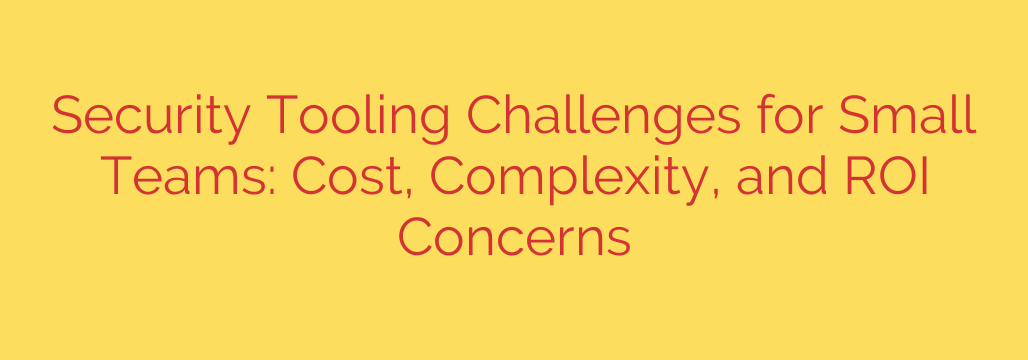
Navigating the Cybersecurity Maze: Why Small Teams Struggle and How to Succeed
For small businesses and startups, the primary focus is growth. Every resource, from budget to manpower, is dedicated to developing products, finding customers, and scaling operations. In this high-stakes environment, cybersecurity can often feel like a secondary concern—a complex and expensive problem to be dealt with “later.” However, with cyber threats becoming more sophisticated and widespread, “later” is no longer an option.
Small and medium-sized businesses (SMBs) are increasingly attractive targets for cybercriminals, precisely because they are perceived as having weaker defenses. Yet, when these teams try to bolster their security, they run into significant roadblocks. Understanding these challenges is the first step toward building an effective and sustainable security strategy.
The High Cost of Security: A Major Hurdle for Small Budgets
One of the most immediate and daunting challenges for any small team is the cost of security tooling. Enterprise-grade security solutions are often priced for large corporations with deep pockets, putting them far out of reach for a growing business. This isn’t just about the initial license fee; the total cost of ownership can be staggering.
The initial price tag is often just the beginning, with hidden costs for implementation, training, and ongoing maintenance. A powerful security tool is useless if your team doesn’t know how to configure or manage it. This requires either hiring specialized talent—which is expensive—or investing in extensive training, which takes time away from core business activities. For a small team where every dollar is scrutinized, the financial barrier can seem insurmountable.
Drowning in Complexity: When Security Tools Overwhelm
Even when a small team manages to afford a security tool, they face the next major hurdle: complexity. Modern cybersecurity platforms are incredibly powerful, but they are also notoriously complex. They come with intricate dashboards, countless configuration options, and a constant stream of alerts.
Without a dedicated Security Operations Center (SOC) or a team of security analysts, this complexity can be paralyzing. A single IT person or a developer wearing the “security hat” is suddenly responsible for interpreting cryptic logs and prioritizing a flood of notifications. Without dedicated security experts, complex tools can lead to misconfigurations and overwhelming alert fatigue, rendering them ineffective. An improperly configured firewall or a sea of ignored alerts can create a false sense of security while leaving critical vulnerabilities exposed.
The ROI Conundrum: How to Justify Proactive Security
In a business environment driven by measurable results, security spending presents a unique challenge: proving its return on investment (ROI). When you invest in a new marketing campaign, you can track leads and sales. When you hire a new developer, you see new features being built.
But how do you measure the value of a data breach that didn’t happen?
Unlike sales or marketing tools, the return on investment for cybersecurity is often invisible—it’s the catastrophic event you successfully prevented. This makes it difficult for a team lead or IT manager to justify the budget to executives who are focused on tangible growth metrics. The conversation often becomes a difficult exercise in trying to quantify a negative, which is far less compelling than presenting a clear, positive return.
A Strategic Path Forward: Practical Cybersecurity for Small Teams
While the challenges are significant, they are not unbeatable. Small teams can achieve a strong security posture by adopting a smarter, more strategic approach. Instead of trying to imitate the massive security programs of large enterprises, focus on efficiency and impact.
Here are actionable steps to build a robust defense on a realistic budget:
Master the Fundamentals. Before spending a dime on advanced tools, ensure you have the basics covered. This “security hygiene” is your most cost-effective defense. Implement strong password policies, enable multi-factor authentication (MFA) everywhere possible, maintain a regular software patching schedule, and conduct basic security awareness training for all employees. These foundational steps eliminate the vast majority of common threats.
Choose Consolidated, User-Friendly Tools. Instead of buying separate tools for every conceivable threat, look for unified platforms designed for SMBs. Many modern security providers offer solutions that combine endpoint protection, monitoring, and threat detection in a single, easy-to-manage dashboard. This reduces complexity, lowers costs, and streamlines management. Consider a Managed Security Service Provider (MSSP) to outsource the expertise if it’s not available in-house.
Adopt a Risk-Based Approach. You cannot protect everything equally, so don’t try. Identify your “crown jewels”—the most critical data and systems essential to your business. Is it your customer database? Your proprietary source code? Your financial records? Prioritize protecting your most critical assets first. This risk-based model allows you to focus your limited budget and resources where they will have the greatest impact.
Reframe the ROI Conversation. Stop trying to calculate the ROI of prevention. Instead, frame the discussion around risk management and business continuity. The question isn’t “What is the return on this investment?” but rather, “What is the potential cost of inaction?” By presenting cybersecurity as a necessary insurance policy against devastating financial and reputational damage, you can make a much more compelling case for the investment.
By focusing on fundamentals, choosing appropriate tools, and adopting a risk-based mindset, small teams can move from feeling overwhelmed to feeling empowered. Building a resilient defense is not about having the biggest budget; it’s about making the smartest choices to protect what matters most.
Source: https://www.helpnetsecurity.com/2025/08/05/aayush-choudhury-scrut-automation-lean-security-teams/








